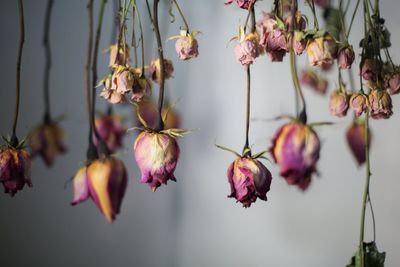Flower Drying Methods
Always collect flowers that are in peak condition – almost completely open and free from insect damage or breakage. Use pruning shears or scissors to cut the stems when plants are dry to avoid mold. Remove leaves from the stem, as they don’t dry well. If planning to wire the stems, do so before drying. The most popular flower-drying methods are air drying, chemical drying, and pressing. It is also possible to preserve stems and leaves with a glycerin soak. Experiment with different flowers and drying methods to find what works best for you.
Air Drying
The easiest and least expensive method of drying flowers is by air drying. Simply bundle several stems together and tie at the base. Hang upside down in a warm, dark room (such as a closet) for two to three weeks. Good flowers for this method include:
Artemisia
Baby’s breath
Globe amaranth
Liatris
Blackberry lily
Celosia
Chinese lantern
Coreopsis
Statice
Strawflower
Yarrow
Rose
Chemical Drying
Most professionals recommend preserving flowers from the garden by using silica gel, available in craft stores. Although expensive, silica gel can be reused many times. Flowers shrink less and hold their shapes better. Preserving color when drying flowers works best with this method, too. Leave plants and flowers in the mixture in an airtight container for several days to a week, depending on the flower. For faster results, silica gel can be used in the microwave in an uncovered, glass container. Times vary from one minute for smaller, thinner flowers to three minutes for thicker-petaled flowers. When dried, remove from microwave, but leave in the silica gel for 12 to 24 hours. To make your own less expensive mixture, combine equal parts of borax and white cornmeal. With this mixture, do not cover, but allow to air dry for one to three weeks. Flowers suitable for chemical drying include:
African violet
Bleeding heart
Coneflower
Dahlia
Daylily
Iris
Lily
Peony
Snapdragon
Zinnia
Pressing flowers
Weighting leaves and flowers between paper is another method of drying flowers. Layer the plants between sheets of newspaper, paper towels, or wax paper and top with heavy weights such as bricks or books. This method often is used when designing a framed picture. Place the flowers, foliage, or leaves in the desired shape and top with paper and weights. Leave in a warm, dry room for two to four weeks. Plants ideal for pressing include delicate flowers such as:
Ageratum
Butterfly weed
Coral bells
Heliotrope
Larkspur
Pansy
Many foliage plants, like ferns, and tree leaves are great for this method too.
Glycerinizing
To preserve stems and leaves for your arrangements, combine one-part glycerin to two parts warm water in a glass jar. Crush the lower 4 inches (10 cm.) of the stems and place in the glycerin mixture. Mark the level of liquid on the glass and, as the liquid is absorbed, replace with a reserved mixture of one-part glycerin to four-parts water. During this process, the color of the leaves will gradually change. It may take one to three weeks for your branches to glycerinize. Preserving flowers from the garden is easy and fun. Drying flowers for your own décor or to use as gifts is a long-lasting way to enjoy your favorite seasonal flowers year-round.
